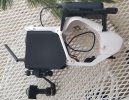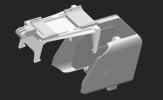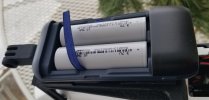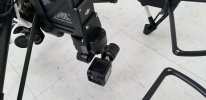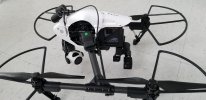- Joined
- Dec 13, 2015
- Messages
- 920
- Reaction score
- 496
- Age
- 77
Since day one it was obvious that Inspire 1 flight time is way too short for serious filmmaking. With TB47 battery and X5 camera payload Inspire could stay airborne for 10-11 minutes, perhaps 15-16 minutes with beefier TB48 battery. Things get even worst with arrival of excellent, but chubby X5R camera ... Sometime between 2015 and 2016 damoncooper pioneered - with heroic persistence and efforts, but successfully - the concept of employing hard wired auxiliary batteries to support weak TB cartridges. He reached solid 25 minutes of flight time with available LiHV packs of certain capacity and discharge rate. Within several months the thread he created on this forum (Battery Mod Info) ballooned to a record 100 pages long behemoth. Unfortunately the main topic and conclusive/valuable information get quickly buried deep under layers and layers of repetitive discussions carried by others. Damoncooper is a legend, gone fishing long ago ...
Meantime the scenario changed drastically, but the main goal remains the same: how to keep old Inspire 1 alive and kicking, having TB47/48 batteries available no more? There's a few ways to do it. By far none, however, is able to bypass the necessary involvement of original "smart" circuitry TB batteries are equipped with. Therefore for now we are at the mercy of these boards and battery tops, recycled from old exhausted ones. Moreover, almost all solutions are of DIY kind, requiring top notch skills. Here's the list of options and alternative solutions for beginning of 2021:
1. Damoncooper way. For those of us lucky enough to have relatively healthy TB47/48 batteries, reinforcing them with hardwired generic packs is still a valid way. The thread mentioned above contains vast and detailed info how to, mostly within first 25 pages.
2. HeliEngadin way. This is easy, assuming the availability of old battery. The company is re-cycling the circuitry and all hardware, replacing depleted cells with new ones. The price seems to be right, but you must ship retired battery to Switzerland.
3. TB47/48S battery cannibalizing. This is the most elegant, but rather desperate way. These batteries are used to power DJI M600 drone and are still available. The pack and housing is identical, but the battery top must be replaced. This involves re-soldering main leads, replacing balancing harness and temp probe, finally swapping data wiring configuration. Tasks not easy for weekend warriors, but doable.
HeliEngadin team is among first to employ the concept of replacing exhausted cells. The exact same replacement cells can be sourced from Chinese merchants, most likely on Aliexpress. The shipment cost to NA, however, is almost killing the whole idea. On the other hand, re-soldering and re-assembling is a mission next to impossible for unskilled person ... Meanwhile some other, equally brave (mad?) nerds are trying to solder different cells of bigger capacity. Cruzroy ( ) is another batt modder and tireless crusader who unknowingly tried to replicate damon's approach with rather disappointing results, but recently tested custom China assembled packs of 9000 and even crazy huge 12000mAh capacity. This approach seems to be the most promising in search for long term solution. However, the access to original "smart" circuitry is still required. Moreover, certain telemetry data of old packs (i.e. battery capacity, cycles count) appears to be permanently embedded in memory and can't be reset without proprietary software intervention. It is also unclear if completely dead batteries are indeed locking the "smart" circuitry into non-reversible state of impotence. Sooner or later somebody will find the way to hack the code, but 3rd party circuit boards smart enough to deliver the goods are less likely to happen ...
Meantime the scenario changed drastically, but the main goal remains the same: how to keep old Inspire 1 alive and kicking, having TB47/48 batteries available no more? There's a few ways to do it. By far none, however, is able to bypass the necessary involvement of original "smart" circuitry TB batteries are equipped with. Therefore for now we are at the mercy of these boards and battery tops, recycled from old exhausted ones. Moreover, almost all solutions are of DIY kind, requiring top notch skills. Here's the list of options and alternative solutions for beginning of 2021:
1. Damoncooper way. For those of us lucky enough to have relatively healthy TB47/48 batteries, reinforcing them with hardwired generic packs is still a valid way. The thread mentioned above contains vast and detailed info how to, mostly within first 25 pages.
2. HeliEngadin way. This is easy, assuming the availability of old battery. The company is re-cycling the circuitry and all hardware, replacing depleted cells with new ones. The price seems to be right, but you must ship retired battery to Switzerland.
3. TB47/48S battery cannibalizing. This is the most elegant, but rather desperate way. These batteries are used to power DJI M600 drone and are still available. The pack and housing is identical, but the battery top must be replaced. This involves re-soldering main leads, replacing balancing harness and temp probe, finally swapping data wiring configuration. Tasks not easy for weekend warriors, but doable.
HeliEngadin team is among first to employ the concept of replacing exhausted cells. The exact same replacement cells can be sourced from Chinese merchants, most likely on Aliexpress. The shipment cost to NA, however, is almost killing the whole idea. On the other hand, re-soldering and re-assembling is a mission next to impossible for unskilled person ... Meanwhile some other, equally brave (mad?) nerds are trying to solder different cells of bigger capacity. Cruzroy ( ) is another batt modder and tireless crusader who unknowingly tried to replicate damon's approach with rather disappointing results, but recently tested custom China assembled packs of 9000 and even crazy huge 12000mAh capacity. This approach seems to be the most promising in search for long term solution. However, the access to original "smart" circuitry is still required. Moreover, certain telemetry data of old packs (i.e. battery capacity, cycles count) appears to be permanently embedded in memory and can't be reset without proprietary software intervention. It is also unclear if completely dead batteries are indeed locking the "smart" circuitry into non-reversible state of impotence. Sooner or later somebody will find the way to hack the code, but 3rd party circuit boards smart enough to deliver the goods are less likely to happen ...


